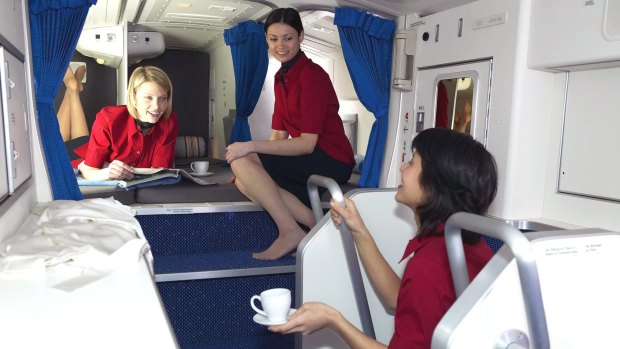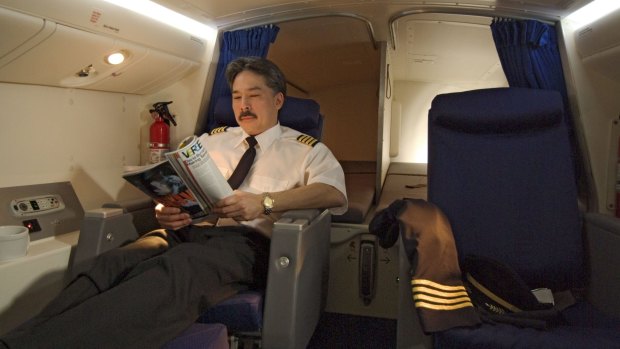This was published 1 year ago
Pilot and cabin crew sleeping compartments on planes: How and where crew get their sleep

The cabin crew in a rest area on board a Boeing 777, which sits above the economy class cabin.
On May 1, on a flight from New York to Rome, the captain of an Airbus A330 operated by Italy's state-owned flag carrier fell asleep at the wheel. His co-pilot was also napping but his was an approved rest period, standard practice on a long flight.
As the aircraft passed close to Marseilles, French air traffic controllers tried to contact the pilot in command, with no response from the somnolent captain.
Panic set in. Fearing a hijacking, the French contacted ITA controllers who tried to rouse the pilots, which they did after 10 minutes. Nothing to see here, the pilots assured them, and the rest of the flight right up until touchdown was standard.

The pilot rest area on a Boeing 777 features two seats with two bunk-style beds behind.Credit: Boeing
None of the passengers or cabin crew would have noticed anything untoward. The aircraft was on autopilot, also standard practice, and hadn't deviated from its course during the cruise snooze. No harm done.
But ITA didn't see it that way. At least one pilot is expected to be awake and on duty, and since that didn't happen the airline gave the captain his marching orders.
Pilots falling asleep is within aircraft operating guidelines, but those guidelines are tight.
According to Australia's Civil Aviation Safety Authority's order 48.1, "Fatigue Management", a tour of duty – the period when a crew member clocks on pre-flight until they are relieved of duties at the end of their flight – must not exceed 14 hours. Most other jurisdictions have similar rulings, including the requirement that they not remain at the controls in the cockpit for more than eight hours.
If, during that 14-hour tour of duty period, a pilot has had two or more hours of sleep time, the tour of duty may be extended by three hours, or the duration of the sleep time, whichever is the lesser figure.
Even with that extension, that's well short of the long-distance flights that aircraft are capable of. Including some of the ultra-long flights Qantas is now operating, such as Darwin to London, and the 20-hour marathons that the airline is planning when it begins non-stop flights from our east coast cities to London and New York.
The workaround
Airlines get around this problem by operating aircraft with two flight crews each with a pilot and co-pilot working in shifts.
On Qantas' experimental Project Sunrise flight from New York to Sydney in 2019, all four pilots were in the cockpit for the first 90 minutes of the flight, then two pilots took a 2½ hour break. Those two pilots replaced the other duo for the next 5½ hours, followed by 5½ hours of sleep then 2½ hours in the cockpit with all four pilots back on duty for the final approach and landing.
These long-haul aircraft have dedicated crew rest compartments. In an A380 the pilots' rest compartment is located just aft of the cockpit. Aboard Boeing's 787 Dreamliner it's above the main deck, up a short flight of stairs above the forward cabin.
In other twin-aisle aircraft pilots' sleeping quarters might be below or adjacent to the cockpit. They're functional, but a long way short of the sort of luxury that first-class passengers get in a private suite. Images of flight crew quarters show two thin mattresses side by side, each slightly wider than a single bed with a curtain divider.
Cabin crew have separate rest compartments located further back in the aircraft. Since there are more crew than pilots, their compartments have four or even six mattresses, sometimes stacked in bunk beds. You might catch a glimpse of a crew member slipping into a sleeper but that's about as rare as a tiger sighting, and as close as you'll ever get. Passengers are strictly forbidden from crew rest compartments.
Do pilots bend the rules?
A pilot napping when he shouldn't is probably rare – or is it? If the ITA incident happened when the aircraft was over the Atlantic Ocean and further from land, there was less chance the captain would have been contacted by ground control, and less chance of being caught.
In early May I flew with ITA from Rome to Palermo. Sitting in the next seat was an ITA first officer, three gold circles on his cuffs, and he was checking emails on his mobile phone right up until the aircraft pushed back from the gate, a couple of minutes after cabin crew made an announcement asking all passengers to switch phones to airplane mode.
As misdemeanours go, that's a long way short of a hanging offence, and a couple of other passengers around us continued tapping on their phones until the aircraft turned into its takeoff roll.
See also: The new must-have feature for business class seats
See also: The best plane and seat for getting sleep on a flight
Sign up for the Traveller newsletter
The latest travel news, tips and inspiration delivered to your inbox. Sign up now.